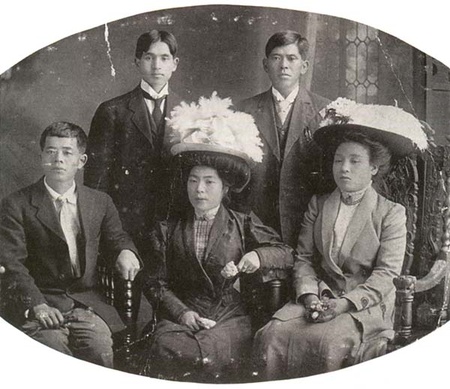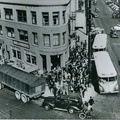Read Part 15 >>
Because the United States government did not recognize the legitimacy of the picture bride marriages, mass marriages took place in immigration stations, hotel lobbies, churches, or at the wharf in Hawaii. “This undesirable practice of an assembly-line type marriage ceremony must be abandoned forthwith,” blasted Kinzaburo Makino in his inaugural issue of the Hawaii Hochi. [A]nd the picture brides should be allowed to have the privilege of having ceremonies conducted according to their own religious faiths after debarkation.”1 After much protest from the Japanese community, this practice of mass weddings was finally stopped in 1917.

A typical Meiji Era (1868-1912) wedding kimono worn by Matsu Saito Oyama, 1914. (Courtesy of Barbara Kawakami, Japanese American National Museum. [92.12.1]) Victorian Blouse and skirt of Tazu Tagawa. (Gift of the Tagawa Family, Japanese American National Museum. [98.351.4 / 98.351.5])
On the Mainland. The western clothng store was probably one of the first stops for the Issei woman, where kimono and sandals were replaced with high button shoes, bustles, and Victorian dresses. Bunshiro Tazuma, owner of the N.P. Hotel in Seattle, remembered the four busy months in the summer of 1924, when 3,000 brides arrived in Seattle, beating the final deadline the government had set when the Immigration Act of 1924 terminated further immigration from Japan. The Japanese district bustled with the gaiety of a festival-like atmosphere. Ladies’ ready-to-wear shops stayed open around the clock as seamstresses busied themselves with alterations. “The new brides could wear the clothing well enough,” recalled Tazuma, “but the problem was the shoes. Since there was none small enough, the women had to clop around in oversized footwear like a brood of ducks.”2
Whether the women settled in the city or the countryside, in Hawaii or the Mainland, the housing that awaited them was bleak. “Yare, yare (Dear, dear).” thought Tsuru Yamauchi when she lived in Camp 35 while working at the Waipahu canefields of Hawaii. Her new surroundings were much poorer than in Okinawa. The long windowless building, partitioned into separate rooms, housed over twenty workers. “The type of room for married people was small, no bed or anything,” recalled Tsuru. “It was just a space to lay the futon (thick bedding) down to sleep.”3
One of the first places Kiyo Mukai lived in was a barn. “The horses were on one side and we stayed on the other.” In the morning, when Mrs. Nakayama (the owner of the barn) asked Kiyono, “Did you sleep all right?” she answered, “I couldn’t sleep a wink because the smell of the manure nauseated me so much.” Mrs. Nakayama patted Kiyono on the back and smiled, “Oh, congratulations! You are in a family way!” Kiyono blushed with embarrassment.4
Living in isolated areas where the closest neighbor was miles away, the women told of their loneliness and longing for home. “Every time I heard the train whistle, I wanted to just get on the train and go back to Japan,” lamented Kiyono Mukai. “When the quails cried ‘oka-ka, oka-ka ’ it really made me lonesome. Even the birds were crying ‘mama, mama’.5
Five miles on all sides,
And not one neighbor in sight!
How many days gone?
How many day still to come?
Today’s just like all the rest…6
If Kiyono had stayed in Japan, her essential duty as a young bride would have been to learn the “ways of the family” from her mother-in-law and to obey her instructions and commands. As Confucian Nakae Tokju stated in his moral treatise for women: The fundamental reason for man to take a wife is that she may serve his parents and bear heirs to continue the succession.”7 Should a dispute arise between herself and her mother-in-law, Kiyono’s husband would have been expected to side with the latter.
But in America, Kiyono, like many other Issei women, did not have to contend with a mother-in-law and her husband’s extended family. One Issei woman stated, “If I married well in Japan, there would be a mother-in-law and for the kind of willful girl I am, that would be pretty hard. So my father thought I should go where there would be no in-laws…there wouldn’t be much to start with, but by my own strength, I could make a go of it.”8

Photo of Sakino Hiraoka (bottom row, far right) and her husband Tamejiro Hiraoka (back row, right) taken upon Sakino's arrival. San Francisco, 1911 (Gift of Hiraoka Family, Japanese American National Museum. [98.86.4])
Notes:
1. Michiye Makino and the compilation Committee for the Publication of Kinzaburo Makino’s Biography (Eds.), Life of Kinzaburo Makino (Japan, 1965), p. 21.
2. Bunshiro Tazuma, Ito, Issei, pp. 200-201.
3. Tsuru Yamauchi interview, Uchinanchu , p. 489.
4. Interview with Kiyono Mukai, Fowler, California, July 8, 1981.
5. Interview with Kiyono Mukai, July 8, 1981; oka-san means mother in Japanese.
6. Teiko Tomita, Ito, Issei, 429.
7. R.P.Dore, City Life in Japan (Berkeley, 1985), p. 98.
8. Anonymous interview translated by Masa Moriguchi and Nancy Araki, September 20, 1974, and Issei Women’s Panel sponsored by the San Francisco Center for Japanese American Studies.
* Issei Pioneers: Hawai‘i and the Mainland, 1885-1924 is the catalogue accompanying the National Museum’s inaugural exhibition. Using artifacts from the National Museum’s collection to tell the story of the courageous “Issei Pioneers,” the catalogue focuses on the early immigration and settlement years. To order the catalogue >>
© 1992 Japanese American National Museum





